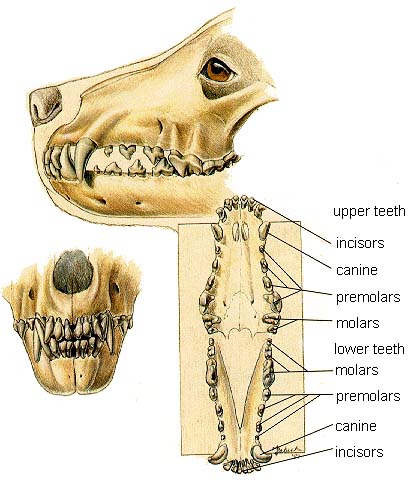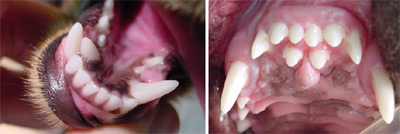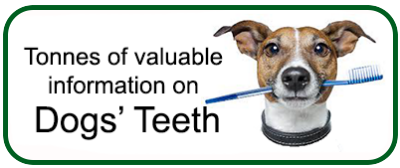Every thing you need to know about
dog dental facts

Dog dental facts
I have collated below a list of interesting dog dental facts, which I hope you will find useful when taking care of your dog's dental health.
And in addition I have supplied links to a huge selection of Only Natural Dog Dental Care Products ranging from toothbrushes and toothpaste to plaque blasters as well as dental treats and chews.
Remember, proper dental care and Brushing your dogs teeth regularly are as important to your dog's health as they are to yours. Just as you owe it to yourself to maintain good oral hygiene you owe it to your dog to provide regular proper dental care and cleaning.
Fact one
Oral and dental diseases are very common in companion animals. In fact, Gum disease (periodontal disease) is the most common clinical condition that dogs present to veterinarians for. It causes halitosis (bad breath), oral pain and discomfort, behavioral changes such as reduced appetite, and can affect organs such as the brain, heart, kidneys, lungs and liver.
Fact two
Studies show that by age three, 80 percent of dogs in the US exhibit signs of gum disease. Symptoms include yellow and brown build-up of Plaque and Calculus along the gum line, red inflamed gums and persistent bad breath (halitosis).
Fact three
Small dog breeds are at risk and more likely to develop periodontal disease than large dogs. This is because the teeth of small dogs are very often too large for their mouths and over-crowding develops.
Fact four
Puppies are born without any teeth, by the time they are a month old most of their baby (deciduous) teeth will have erupted.
Fact five
In total, puppies have 28 baby teeth, 14 in the lower jaw (mandible) and 14 in the upper jaw (maxilla).
Fact six
Their permanent teeth start to come through around 4 months old. As in human children the pressure from their permanent teeth coming through, has the effect of causing the roots of the deciduous teeth to absorb, and most times they just fall out.
Fact seven
Dogs will have most of their permanent dentition by the age of 8 months give or take a week or two. Adult dogs end up with 42 permanent teeth, 22 on the lower jaw and 20 on the upper jaw. The Chow Chow is the exception to the rule with 44 teeth in total.
Fact eight
Normally dogs end up with 6 permanent molar teeth which have 3 roots each, and 14 premolar teeth which have 2 roots each, the remaining incisors and canines have 1 root only.
Fact nine
Nature intends that when a baby tooth falls out the corresponding permanent tooth emerges to replace it. However sometimes the baby tooth continues to just sit there, the name given to these teeth is "retained deciduous teeth". If this happens to your dog, please make an appointment with your family vet to have it/them removed - it is important in young dogs to see their occlusion is kept in correct alignment.
Fact ten
"Dogs are not entitled as of right to have a perfect bite, but they all deserve a comfortable one", is a common saying amongst dog orthodontists.
Research indicates that malocclusions very often have a genetic component, and therefore it is correct to state that malocclusion are hereditary, rather than acquired, e.g. by chewing on toys or playing tug-of-war games.
It is considered Fraud in the US for breeders and vets to correct a malocclusion for the purpose of Dog Shows.
Fact eleven
Supernumerary (extra teeth), oligodontia (only a few teeth) and anodontia (no teeth), are all conditions with an abnormal number of teeth. Supernumerary is the most common form of abnormality.

Supernumerary Teeth
Supernumerary teeth can cause over-crowding, a predisposition to Periodontal disease, malocclusions and or teeth grinding (bruxism). Supernumerary teeth are quite common in dogs and most times it is either incisors or premolar teeth which are involved. Obviously you must seek advice from your family vet to have them removed.
Fact twelve
Broken teeth can be a problem with dogs, especially among outdoor working dogs that use their canine teeth to carry prey or other objects for their owners. In a domestic situation owners will probably opt for extractions, because having crowns made and fitted is expensive.
However in the case of working dogs it is possible for vets to fit metal crowns on broken teeth to extend the working life of dogs. Either way, immediate Veterinarian treatment is necessary because broken teeth are horrendously painful.
This article and information forms part of the Carole's Doggie World Library and is presented for informational purposes only.The information is not intended to be a substitute for visits to your local vet. Instead, the content offers the reader information researched and written by Carole Curtis for www.carolesdoggieworld.com







